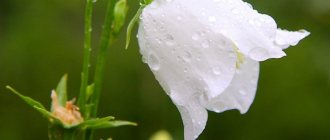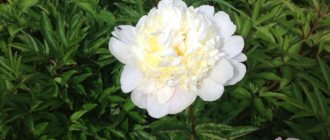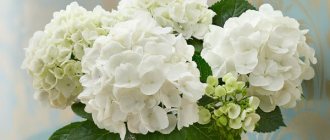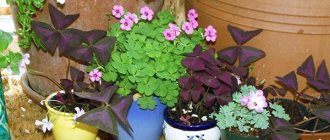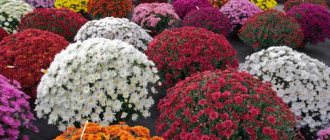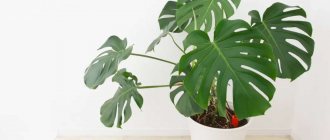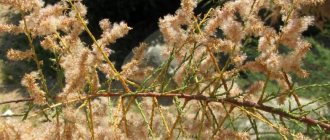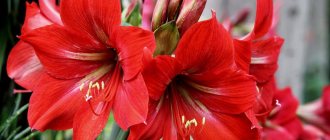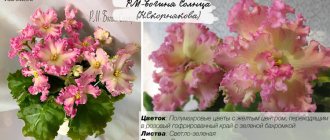What does a begonia flower look like: characteristics of the plant
Begonia is a genus of plants containing more than 1,600 different species. Depending on the species, it can grow as a herb, shrub or subshrub.
Description
The root system is divided into three types: branched, fibrous and tuberous.
For your information! Begonias with a tuberous root system, unlike other species, grow well both indoors and in the garden.
The leaves are asymmetrical, can be whole or dissected, with jagged and wavy edges.
Flowering of a representative of the home flora
In plants of the genus Begonia, the upper part of the leaf can be solid green or other colors with various inclusions, strokes, and patterns. The lower part has shades of red, brown and dark purple. The stems and leaves of many species are covered with small hairs.
Inflorescences vary from small to large. They have a wide variety of colors: white, pink, yellow, orange, red, with edging around the edges of the petals. After pollination, fruits are formed in the form of a triangular box with seeds inside.
It usually blooms in summer-autumn, but under indoor conditions flowering continues until December.
Diseases and pests
It is worth noting that with proper care, Begonia rarely gets sick and is subject to attacks by pests. But anything can happen.
The most common disease in Cleopatra is a fungus . Which is characterized by rotten spots on the leaves. In order to prevent the disease from spreading, get rid of the affected parts of the flower, and treat the remaining parts with a fungicide solution. From now on, to avoid such troubles, control the temperature in the room.
The leaves lose their richness and begin to turn yellow due to dry air and excess liquid. Brown pigmentation indicates a lack of nutrients.
Your beauty does not please you with its active flowering and rapid growth due to the lack of potassium and phosphorus in fertilizers, or their insufficient quantity.
Flower care
Caring for begonias at home is easy and simple. Good lighting and the absence of direct sunlight are important for this plant. The most comfortable temperature for a flower is 18 °C.
Landing
Euphorbia flower - types and popular varieties
It is better to plant in spring, at the end of March. Planting in open ground is carried out at the end of March, so as not to frostbite the plant. For this species, it is recommended to choose larger pots. One third of them need to be filled with a drainage layer of expanded clay, coal or shells.
The soil
It is best to use slightly acidic soil (pH = 5.5-6.5), consisting of peat, leaf and turf soil, and coarse river sand.
Note! To increase the acidity of the soil, add calcined soil from coniferous trees.
Watering
Begonia is a tropical plant, so it is necessary to ensure sufficient air humidity in the room (60-70%) to prevent the leaves from drying out. It is recommended to water when the top layer of soil dries to a depth of 1-2 cm. In summer, the plant needs more frequent and abundant watering. Before this, the water is left to settle for 24 hours.
Reproduction
Reproduction is carried out in four ways.
- Seeds. You need to germinate the seeds at the end of January, spreading them on the surface of the ground without sprinkling them. The pot with seeds is placed in a warm, well-lit room, you can put it under a lamp and cover it with film. After four sheets appear, a pick is made. Two months after sowing the seeds, the seedlings are transplanted into individual pots.
- By cuttings. This method is recommended for propagation in early summer. Branches with 3-4 leaves are cut from the bush and placed in a container with water until roots appear. This will happen in about a month. You can also immediately plant the cuttings in the ground and moisten the soil when it dries out by 1 cm.
- By dividing the tuber. This method is used to propagate in the spring. The plant is pulled out of the ground and the tuber is divided into several parts. Each division must have roots. Tubers are planted in separate pots.
- Leaf. Both whole leaves and their parts are suitable for propagation. The main veins are cut into them and placed in calcined soil. The leaves need to be watered through a tray.
Reproduction methods
Maple leaf begonia can be propagated in three ways:
For the first method, cut flower shoots about 6 cm long and place them in water until the first roots appear. After this, feel free to replant it in the ground and watch how your “baby” will delight you with its rapid development.
To plant begonia with leaves, select a large and intact leaf blade and pinch it off along with the petiole. With this method of propagation, the shoot can be immediately planted in a flowerpot and can be fertilized, like an adult flower, every two weeks.
The third breeding option is the most painstaking, but at the same time very interesting. To do this, we sow the planting material in the same soil as for ordinary pots with Begonias, and lightly press it. Then we don’t water (this is important!), but spray the soil. Cover the box with the seeds with film or a plastic lid and move it to a warm place. After the first sprouts emerge, we begin to harden the seedlings by opening the film daily.
So small plants must get used to relatively dry air. This type of breeding should take place from early March to June. There is no point in planting seeds later.
Begonia everblooming and its types
Types of geranium - what happens, popular varieties
The ever-blooming plant reaches a height of approximately half a meter. The color and size of the leaves differ depending on the variety. The inflorescences of this species are usually small and have two-colored petals.
The Begonia Semperflorens group includes a large number of varieties that bloom regardless of weather conditions throughout the summer.
The most famous varieties:
- Coctail is a low bush with brick-colored leaves and flowers characteristic of the crop;
- Ambassador is a plant with green leaves, a thin red border, flowers can be of various shades. Red begonia of this variety is in great demand;
- Baby Wing - a species with bronze leaves and flowers of various shades;
- Bicola is a low bush measuring only 13 cm. The leaves are green. The flowers are white with a pink edge;
- Alba is a tall spreading bush 40 cm high. The leaf blades are green, the flowers are large, white.
Classification of begonias
To date, there is no generally accepted classification of this culture. Various sources divide species and varieties into 3-9 groups. Interestingly, there is no option that considers only deciduous and beautifully flowering Begonias; at least, shrubs that form powerful vertical bushes are added to the list.
The division itself is very arbitrary; some species can be included in two or more groups at the same time. For example, Begonia boliviensis is placed in catalogs in the sections of ampelous, shrubby or beautifully flowering.
The classification below does not claim to be the best. For flower growers who are just starting to study begonia varieties, on the one hand, unnecessary complication is not necessary. On the other hand, this is necessary:
- Think about what the plants might look like;
- Recognize them by photos and names;
- Understand that a certain species or variety of begonia can be difficult to care for;
- Can the flower be kept on a windowsill or will it require a special environment.
Royal begonia: types, varieties
Dracaena - types and popular varieties
Begonia Rex is a hybrid species of ornamental plant. The differences between this variety are its rather large leaves and small flowers (up to 1 cm in diameter).
The most popular varieties of Begonia rex:
Royal begonia
- Escargot is a bush-like plant up to 30 cm in height and 45 cm in diameter. The leaves are twisted in a spiral, they are light green with a dark edge, covered with villi;
- Mini Merry Christmas is the most variegated variety, measuring approximately 30 cm. Leaves have a velvety surface and large veins. Painted in the middle and along the edges in a dark brown, copper color, turning into burgundy red with light green splashes;
- Dollar Down is a bush measuring 25-30 cm. The leaves of this variety are dark red, cherry, dark along the edges, and have a fan shape;
- Dark Mambo is a plant with dark, almost black spiral-shaped leaves;
- Griffin is a flower 40 cm in size. The leaf blades are mostly white with green veins.
Home care
In addition to the above conditions, indoor begonias on the windowsill must also be provided with a special microclimate. To do this, you will need to create the correct care regime, including fertilizing and watering.
Therefore, when cultivating a flower, each plant grower must create a schedule of all possible maintenance measures, which must be adhered to as strictly as possible.
Watering
Water the begonia regularly, but in small portions. The main sign of the need for watering can be a dry soil crust in a flowerpot with a thickness of 0.5 cm. Despite the fact that in nature the flower lives in regions with a humid climate, additional air humidification is not required when keeping begonia.
However, varieties with large leaves require mandatory wet cleaning 1-2 times a month.
Top dressing
Fertilize the plant with both organic and mineral fertilizers. The most suitable organic fertilizer is fresh manure diluted with water in a ratio of 1:5.
For mineral fertilizing, complex mixtures of phosphorus-potassium fertilizers or preparations such as “Bud”, “Ovary”, “Tsveten”, etc. are used. Fertilizers are applied once a month, and the soil must be watered, applying highly concentrated fertilizers to dry soil can cause burns to the root system.
Important! Watering and fertilizing should be uniform; sudden changes in moisture and nutrient concentrations can inhibit the growth of begonias, even to the point of death.
Trimming
Begonia pruning is carried out to rejuvenate the bush, as well as to create its optimal shape and size. The procedure is carried out regularly, at least once a month. The first pruning is carried out when the plant reaches 10 cm in height.
The second - when the flower reaches a height of 12–15 cm, which helps eliminate upright growth. In the future, the procedure is carried out according to schedule or urgent need. Old, damaged and dried parts must be removed; this helps to establish an optimal balance between the size of the flower and the volume of its root system.
The procedure is carried out using a sharp knife. Other instruments cause excessive tissue compression, which has a detrimental effect on wound healing. The cut sites must be treated with powdered charcoal, which helps to avoid infection of the tissues by all kinds of fungi and pathogenic viruses.
Transfer
Plants are replanted as needed when the pot becomes too small. The procedure is carried out every 3-4 years in the spring, which additionally helps to stimulate the growth of begonias, but young flowers are replanted annually (or as needed).
To do this, the plant is carefully removed from the old pot, and then, together with the soil, the root system is treated with a 2% solution of potassium permanganate (for disinfection). The optimal pot is one that is 5–6 cm larger in diameter than the previous one.
Learn how to properly plant indoor plants in a pot.
Elatior
Elatior is a small bush, reaching 25-40 cm in height. The leaves are dense, approximately 8 cm long, and shaped like an asymmetrical heart with jagged edges. Elatior flowers come in two types: simple and double. They form inflorescences in the form of a cascade.
Elatior
The most common varieties of Elatior:
- Balladin. It is distinguished by the splendor of flowering. During this, up to 70 pieces appear on one bush. colors;
- Begonia Borias. The main feature is long flowering.
Begonia redleaf, or Fista
Modest size and lack of flashy details are not always a drawback. And one example is the shade-tolerant Begonia x feastii, Begonia x erythrophylla, which can survive even after critical failures in care.
This is a versatile, deciduous-flowering species with shiny, uniformly dark green above and reddening below, easily damaged, almost rounded leaves on long petioles. The bushes appear spherical; the snake-like creeping shoots lengthen with age and are easily controlled by pruning. Long, curving flower stalks appear between the leaves and bear sparse racemes with soft pink small waxy flowers.
Even almost “naked” shoots of this species can transform with good care. The plant loves everything in between - lighting and temperature, substrate and air humidity. And only feeding should be rare.
Red-leaved begonia, or Fista (Begonia x feastii, Begonia x erythrophylla). © chicoguys
Ampelnaya
The main difference between the ampel type and other varieties is the tuberous root system. The plant reaches a height of about half a meter. The leaf blades are large, 10-15 cm long. It blooms with bright yellow, orange or red flowers, which can be simple or fringed in type.
Ampelnaya
Note! The most famous varieties are Reyvans, Marmorat and Chardon.
Begonia always blooming in landscape design
Always-blooming begonia is used in the design of not only flower beds, but also large spaces. This is an ideal option for carpet plantings and creating various ornaments. Begonia looks good in flower beds and is suitable for borders and edgings. Bushes grown from cuttings of one mother plant allow you to create uniform, even borders.
Begonia always blooming looks good in any garden compositions
Flowering bushes look great in flowerpots. They decorate balconies, begonia is planted in hanging baskets, and included in vertical compositions and living plant sculptures.
Begonia everblooming is suitable for creating different compositions
Coralline
Coral begonia is a tall bush, reaching up to 2 m in height in a greenhouse garden, and will be slightly smaller in indoor conditions. Coralline leaves are 20 cm long and up to 7 cm wide. They are unevenly colored and have white inclusions. During flowering, bright flowers appear in white, orange, pink or red shades.
Coral
World of flowers
It is one of the begonias that tolerates being moved to another place equally well, does not stretch out in winter with a lack of light and does not change the color of the leaves.
Kredner's begonia is one of many indoor begonias of hybrid origin. She has strong growth (up to 120 cm). Begonia flowers are large, white, with red cilia on a long peduncle. Begonia has succulent stems, with a reddish tint, which are densely covered with white and long hairs. The leaves of Begonia Krednera are wide, large, irregularly ovoid in shape, the ends of the leaves are somewhat elongated. The upper part of the leaf is greenish-olive in color, hairy, the underside is red, and also has whitish hairs. This saves them from many indoor pests - they are inaccessible to spider mites, aphids, and whiteflies. And they don’t even have scale insects. Begonia grows as a bush, forming several shoots from one root
The plant calmly tolerates both high and low temperatures (10°C). Under very unfavorable conditions, 1-2 leaves inside the bush dry out and curl up, practically without changing the aesthetic appearance of the plant. In winter, I keep the begonia on a south-facing window, when the sun appears, I move it to the north side, and when it gets warmer, to the loggia, where I leave it until late autumn. The plant grows moderately and does not grow much. He really likes feeding from mushroom infusions. When I bring mushrooms from the forest, I wash them, sort them, and pour the water from under them into bottles. I periodically water the flower with this water. At the same time, the leaves seem to come to life, acquiring a rich and bright color.
In winter, I water the plants moderately at the roots, although more often than in summer, due to steam heating. Additionally, I spray the leaves with water, and sometimes with a solution of microelements. To make the roots feel comfortable, I keep the bush in a double pot. This protects them from hypothermia, and in summer from overheating.
flowersroom.info
Other popular varieties
The following varieties are in great demand among gardeners.
- Begonia Cleopatra. A plant of this species usually reaches no more than 30 cm in height. Its leaves resemble maple leaves. They come in green and burgundy. Cleopatra blooms in January. Inflorescences are white and pink.
- Begonia Mason. It is a leafy variety with a height of approximately 30 cm. The leaves reach 20 cm in length. The flowers are small and beige.
- Fuchsia. Reaches a height of 1 m. The leaves are glossy green. The flowers are painted in bright shades of red.
- Bud de Rose is a large-flowered variety. The delicate pink petals are collected in huge double inflorescences (18 cm in diameter), reminiscent of a rose.
- Begonia Gloire de Lorraine is a winter-blooming species. The plant is small with glossy leaves. The petals are pink.
- Begonia hogweed
- Large-leaved variety. The leaves reach 25 cm. The shape resembles the leaf plate of hogweed, which is why the plant got its name.
- Begonia castor-leaved is a decorative deciduous species that reaches more than 1 m in height. During flowering, delicate pink inflorescences appear.
- Grandiflora is a species with a tuberous root system. The height of the plant depends on the variety. The size varies between 20 and 80 cm. Popular varieties of grandiflora: Orange (low bush 25-30 cm, dark green glossy leaf plates are collected in a rosette, flowers reach a diameter of 10-15 cm); Rose is a small plant with large, rose-like, densely double pink flowers; Yellow - bush 20-25 cm; the Yellow variety is characterized by densely double lemon-colored flowers with a diameter of 10-12 cm.
- Maculata, or spotted begonia. It grows as a bush with large spotted leaves 10-15 cm long. During flowering, the inflorescences form hanging clusters of white and pink flowers.
- Black Prince. The leaves of this variety are painted in a very dark color, close to black. The surface of the sheet resembles velvet.
- Fimbriatus. A plant of the fringed group with a wide variety of colors: pink, red, white, orange. Yellow begonia of this variety looks especially impressive.
- Illumination This variety is characterized by long shoots up to 0.8 m. Illumination flowers are large, up to 12 cm in diameter.
- Carnival. Large-flowered variety, 30-35 cm high. Flowers are camellia-shaped, densely double.
- Drega is a begonia with a caudex trunk.
Note! There are also many more varieties and species, for example, Nona, Nha Trang, Pendula, begonia Belleconia, etc. The diversity of the genus Begonia allows each plant grower to choose a specimen that he likes. This elegant plant will decorate any room with its bright colors.
Coffee capsule Nescafe Dolce Gusto Chocochino, 3 packs of 16 capsules
1305 ₽ More details
Hot chocolate capsules Nescafe Dolce Gusto Chococino, 8 servings
334 ₽ More details
Bed sheets
Photo: Bush with blackberry-like berries
You won’t believe it took my wife and I about half an hour to find out what kind of bush it was before we picked up the trail.
Using the Yandex search engine, we looked through what seemed to be all possible options, including:
- Bush with berries similar to blackberries
- Blackberry-like berry
- Ornamental shrubs
- Shrub with cob-shaped flowers
- Straight growing blackberry
- Types of blackberries
- Blackberry flower
- Ornamental bush similar to raspberry
On one of the sites visited, under the picture of this bush, it was written that it was a goji berry or a Tibetan barberry, but searches for these queries did not yield any results. On another site, under a similar picture, it was written that this is an “insidious berry.”
In the responses to Mail.ru, I found a short excerpt from a large Soviet encyclopedia, and it was written there that this is a type of blackberry called Kumanika, which indeed is somewhat reminiscent of blackberries, but it was still not what we were looking for.
After some more time, my wife began to look through the search for everything that was related to poisonous berries, and then we came across some picture, under which it was written that this plant is called Lakonos .
The next search query gave the desired results and finally we found out what kind of plant this is and whether it can be eaten.
